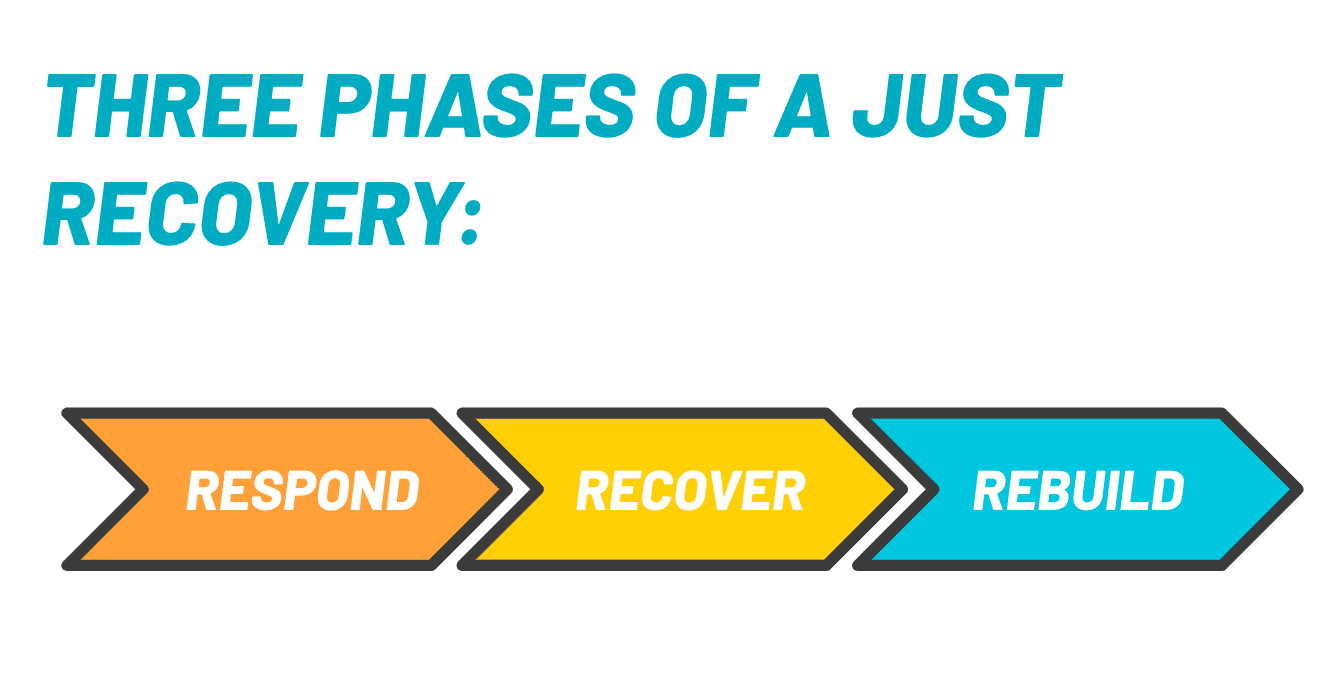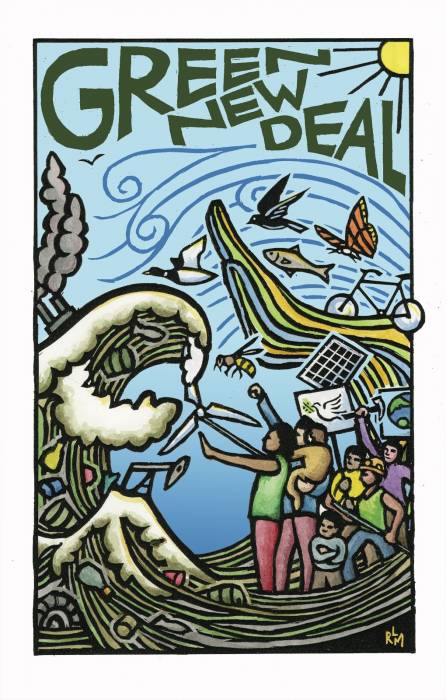350
Let's build power in our communities to fight for the future we deserve:
Host or join a digital teach-in for a
Just Recovery
from the COVID-19 Pandemic
From coast to coast, over 40+ communities across Canada held digital teach-ins to learn how we can win a Just Recovery from May and throughout the summer. Thanks to the people powered movement for a Just Recovery, Trudeau’s government acknowledged the need for a just and “green recovery” to “build back better” when parliament resumes in September.
This Moment
We’re in the midst of an unprecedented crisis. It’s one part pandemic, one part economic crisis, and one part the cumulative impact of converging climate and social crises.
Unemployment has hit a record of 13% — the highest level since WWII. And after years of austerity, our healthcare and social services are buckling under pressure.
How we respond to, recover from, and rebuild after this crisis will define the next chapter of human history. Watch the video below to learn about the 3 phases of a Just Recovery.
We’re organizing teach-ins across the country in support of a Just Recovery.
It’s easy to think that we can’t organize while stuck at home. But with oil and gas lobbyists and corporate CEOs calling up our elected officials every day begging for multi-billion-dollar bailouts, we can’t afford to wait until social distancing is lifted to begin building the movement for a Just Recovery.
Check out the recording from our Mass Strategy Session from May 13th here:
Fortunately, we’ve got a tactic that can not only be done virtually from our homes but one that has laid the foundation for some of the most successful social movements of our time. From Idle No More to Occupy Wall Street, mass movements have used teach-ins to build a shared understanding of the problem they’re up against and their plan to win. And while we might not be able to gather in parks or public spaces (yet!), we can begin building this same understanding and start bringing people into this movement by the thousands.
But to get there, we’ll all need to take responsibility for educating and organizing our communities. That’s why we need you to take a leap and (virtually) gather with your friends, family, and neighbours to talk about our plan to win.
We’ll give you everything you need to host a successful teach-in: a toolkit, slide deck, and speaking notes. Then, alongside hundreds of people, you’ll (virtually) bring your community together so you can take action from home, sending a message to Trudeau and his recovery task force that we all deserve a Just Recovery.
Host or join a digital teach-in
You can host a teach-in by checking out our toolkit, slide deck, and speaking notes. Your teach-in could be as simple as a handful of friends getting together to discuss what a Just Recovery means to you. We encourage you to hold private events within your network. If you have any questions or if you would like to add your event to the map below, you can email us at [email protected].
Find a public digital teach-in. You can use the search bar at the top of the map below or controls in the bottom right-hand corner to find a digital event with people who live in your city or town. Blue dots mark events that have already passed and red dots mark events that are coming up.
Toolkit for Organizing a Just Recovery Teach-In
Here’s a step-by-step guide to organizing a Just Recovery Teach-In. In case you missed it, we have a slide deck, and speaking notes ready for you to use. Please e-mail us at [email protected] if you have any questions that aren’t answered in this toolkit.
Please note that in light of recent events that have lifted the veil on ongoing police and state violence targeting Black and Indgenous people, we have included resources on anti-racism in the slide deck, and speaking notes.
Additional Resources
- Canada-wide movement for a Just Recovery
- June 11th Webinar on Anti-Racism and a Just Recovery (see the recording)
- June 23rd E-rally for a Just Recovery
- Defund the Police
- Submissions in support of a Just Recovery from 500+ people across Canada
- Global movement for a Just Recovery
- Toronto’s movement for a Just Recovery
- Vancouver’s movement for a Just Recovery
- Canada-wide movement for a Green New Deal
- Art Toolkit for a Just Recovery
- Art Toolkit for a Green New Deal
En français
À travers le pays, les gens sont enthousiastes face à l’idée d’une Relance juste qui permettrait une meilleure reconstruction, à la suite de la pandémie de COVID-19. Au cours des dernières semaines, plus de 40 communautés du pays ont présenté des ateliers d’éducation pour une Relance juste.
Cette tactique peut être utilisée virtuellement à partir de la maison. Elle a posé les bases de mouvements sociaux parmi les plus efficaces de notre époque, notamment les mouvements Idle No More et Occupy Wall Street. Ces ateliers d’éducation contribuent au développement d’une compréhension mutuelle du problème auquel nous sommes face, et aident les mouvements à définir une stratégie de victoire.
Voici comment se déroulent ces conversations d’une heure:
1) Les présentateurs décrivent une à une les étapes du moment que nous vivons, au cœur de la pandémie.
2) Ils précisent pourquoi il nous est impossible de revenir à la ‘normale’ une fois la pandémie terminée.
3) Ils présentent le plan en trois étapes – intervention, relance, reconstruction – à mettre en oeuvre à la suite de la pandémie
4) Enfin, les participants décident, ensemble, comment ils agiront pour s’assurer d’une Relance juste.
Vous souhaitez être l’hôte d’un atelier d’éducation auprès de membres de votre communautés? Voici comment faire :
- Planifiez présenter votre atelier d’éducation à l’aide d’un outil de vidéoconférence comme Zoom, GoToMeeting ou Google Meets. Partagez ensuite l’événement avec toutes les personnes que vous souhaitez inviter. Créer un événement Facebook (public ou privé) est un excellent moyen de faire la promotion de votre atelier. Vous souhaitez que nous fassions aussi la promotion de votre événement? Écrivez-nous au [email protected].N’oubliez pas : la pandémie du coronavirus a totalement chambardé notre monde. Résultat : bien des gens sont devenus actifs politiquement pour la première fois de leur vie. C’est le moment idéal pour inviter ces nouvelles personnes à rejoindre notre réseau.
- Une fois votre événement créé, consultez le jeu de diapositives modèles et les notes de présentation. Effectuez les ajustements désirés.
- Trouvez une ou deux personnes qui vous appuient et exercez-vous à utiliser le matériel et la technologie de vidéoconférence avec eux.
- Enfin, présentez votre événement et revenez-nous ensuite pour nous dire comment il s’est déroulé à l’adresse [email protected]. N’oubliez pas : même si vous vous préparez pendant des heures, rien ne sera parfait. Préparez-vous donc à encaisser les coups et à aller de l’avant!
La manière dont nous interviendrons, relancerons et reconstruirons à la suite de cette crise définira le prochain chapitre de l’histoire de l’humanité. Nous ne pouvons nous permettre d’attendre que les mesures de distanciation physique soient levées pour créer le mouvement pour une Relance juste. Pour réussir une Relance juste, il faut que chacun de nous prenne la responsabilité de transmettre l’information et de veiller à l’organisation au sein de sa communauté.

